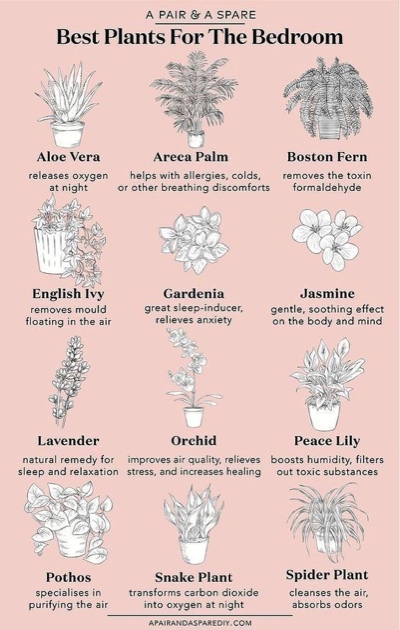
Air purifying plants
1. SNAKE PLANT, aka Mother-in-Law’s Tongue
Sansevieria trifasciata
Long, tongue-like leaves with sharp pointed tips earn the Mother-in-Law’s Tongue name, although certain varieties also resemble the geometrically patterned scales of a snake. One of the top air purifying plants identified by NASA, Sansevieria removes at least 107 known air pollutants, including carbon monoxide and nitrogen monoxide, formaldehyde, chloroform, benzene, xylene, and trichloroethylene among many others. Sansevieria also produces copious amounts of oxygen throughout the night, making it an excellent plant to keep in the bedroom.
Best of all, Sansevieria is an extremely resilient species that can go for weeks without water and seems to thrive in just about any climate, including those with low light, although they do appreciate direct sunlight, which is characteristic of their native habitat of Madagascar.
2. MONEY PLANT
Epipremnum aureum
Money plant earns its common name from its traditional use as a wealth and prosperity booster in the Chinese system of feng shui, which is the ancient art of harmonizing indoor spaces via the strategic placement of furniture, plants and other common household objects. Whether or not it brings you greater abundance or not, Money Plant is a powerful air purifying plant that will clean the air in your house very effectively, due to its particular affinity for volatile organic compounds (otherwise known as VOCs) most commonly in the form of off-gassing from synthetic paint or carpets.
Featured by NASA, the Money Plant is renowned for its ability to remove chemicals and other pollutants from the air, specifically benzene, formaldehyde, xylene, and toluene. However, despite the benefit of its high purification rate, this plant is toxic to cats, dogs, and small children if its leaves are ingested. This is one you can easily find at any plant store (like Mothers Tongue) and what I love about it is that it takes over your home.
3. PEACE LILY
Spathiphyllum
The Peace Lily is a deep, forest green plant with beautiful white flowers. It’s a great general cleanser and air purifying plant that effectively removes all common indoor pollutants generated by furniture, electronics and cleaning products, so much so that it is one of NASA’s top-ranked plants for this purpose. This is another precious plant that requires minimal watering, with the general guideline being once every 4-5 days.
4. BAMBOO PALMS aka Butterfly Palm
Chrysalidocarpus lutescens
The Bamboo Palm is another hardy plant native to Madagascar that does an excellent job as an indoor, air purifying plant, with a particular penchant for formaldehydes, benzene and carbon monoxide. As an added benefit beyond air purification, it is also a natural humidifier, producing a liter of ambient water every 24 hours, making it a well suited plant for dry climates or those with breathing troubles.
Bamboo Palms grow rapidly and can become quite large but you can limit their height by keeping them pruned and confined to smaller pots. When it comes to having air cleaning plants in your home, the rule of thumb is the more the better. Each plant pumps out loads of fresh oxygen and cleans toxins and harmful VOC’s out of the air just how nature intended. If you are ready to go all in and upgrade your indoor air quality, exponentially, this is for you.
5. CHRYSANTHEMUM
Chrysanthemum morifolium
Florist’s chrysanthemums are ranked the highest for air purification. They’re shown to eliminate common toxins as well as ammonia. Brighten up your kitchen or living room with these cheerful and colorful flowers. These pretty blooms help to filter out a host of toxins including ammonia and benzene, which is often found in plastics, detergents, and glue. Treat yourself to a fresh pot, as this flower only blooms for about six weeks. Or you can fertilize the pot again in the spring when new growth appears. But without the flowers, it won’t be purifying the air. If you don’t want to wait, you might want to just get a new pot.

